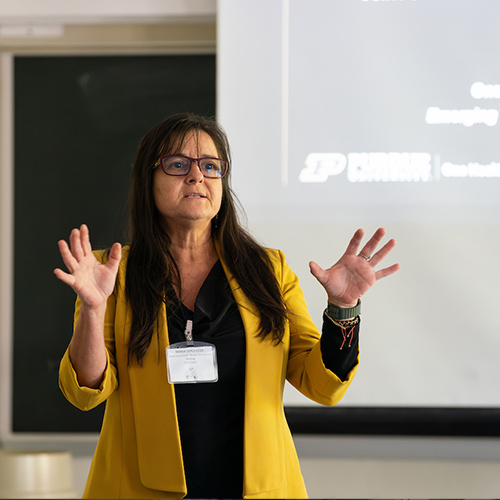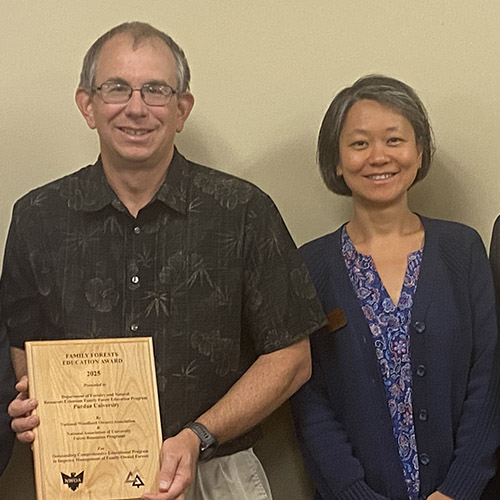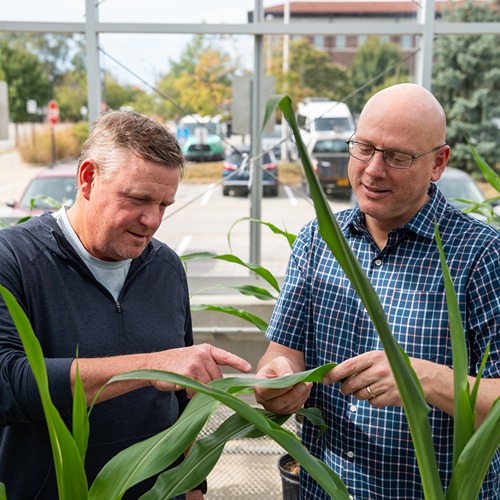Quiz Bowl Team Places Third at TWS Conference
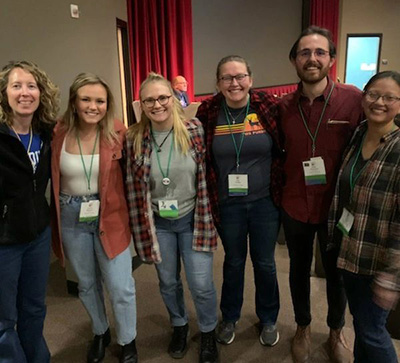 The Purdue student chapter of The Wildlife Society continued its streak of podium finishes at the TWS Quiz Bowl competition in Spokane, Wash., Nov. 6-10, placing third out of 14 teams.
The Purdue student chapter of The Wildlife Society continued its streak of podium finishes at the TWS Quiz Bowl competition in Spokane, Wash., Nov. 6-10, placing third out of 14 teams.
The third-place effort follows a first-place finish in 2019, second place in 2017 and third place in 2018 and 2016.
The 2022 team advanced to the finals alongside the University of Georgia’s Warnell School of Forestry, the University of Montana, and Texas A&M University. The team consisted of junior wildlife and forestry-forest management double major Alex Dudley, junior wildlife major Evan Kinnevan, junior wildlife major Anne Talbot, senior wildlife major Ashlanna Murray and senior wildlife and communication double major Lauren Wetterau,
“It was very exciting to see our studying and preparing pay off,” Murray said. “We didn't go into the competition with many expectations on how we would perform or what we would place. However, we were feeling the pressure since Purdue TWS won first place at the last Quiz Bowl competition in 2019. It was a lot of fun to test our knowledge (and guessing abilities) in that setting and be able to meet students from other student chapters of TWS! Out of 14 teams, we placed 3rd. I feel proud of us for our accomplishment and for making the podium for Purdue TWS, and I am hopeful that the team next year can take back the championship once again!”
Dudley said that the team’s success in Quiz Bowl not only was the result of their studying, but also recalling material from their FNR courses.
“As much as we studied for quiz bowl, a lot of the questions we answered were because of what we’d learned in classes like Wildlife Techniques, Habitat Management, and Ecology/Systematics of Birds & Mammals,” Dudley said. “It was really cool to make the connection of what we learned in class to how it was applicable in Quiz Bowl. There were definitely quite a few questions we couldn’t answer though, and that was super intimidating when you should know the answer from class, and the professor that taught you it is right there. It was really exciting to represent Purdue TWS on the podium. We’ll be competing again next year, so hopefully we can continue improving!
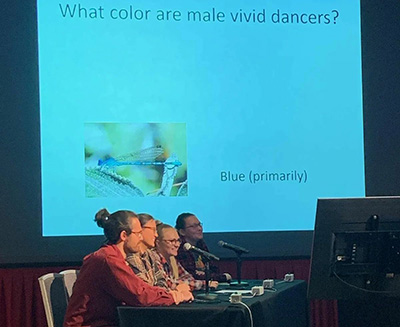 Talbot said finishing on the podium was a great reward for all of the preparations, which began in earnest over the summer.
Talbot said finishing on the podium was a great reward for all of the preparations, which began in earnest over the summer.
“Quiz bowl was an amazing experience,” Talbot said. “We knew we were going to enter the Quiz Bowl competition at the end of last school year. We already had some resources from the previous quiz bowl team, so over the summer, we were able to look over those. When school started and we finalized who would be on our team, we started making quizlets and were able to access the ones our previous team created. Paying attention in class helped us a lot during the competition, but reviewing quiz bowl questions from previous years did help us understand the formatting of the competition better. I think that was really helpful because we kind of knew what we were getting into.
“There was no overlap in the last quiz bowl team to this one, so it was kind of like we were starting from square one. We wanted to represent Purdue well, and I think we did that by making the podium. We were all super excited when we found out we made it to the finals. I am proud of what we were able to do this year and can't wait for next year's conference.”
In addition to an impressive outing at the Quiz Bowl, Purdue Forestry and Natural Resources was well represented at The Wildlife Society conference in Spokane, Washington, Nov. 6-10. Several students, faculty and staff members gave either verbal or poster presentations at the event, while all in attendance were able to network and take in research and education opportunities.
“The TWS 2022 conference was a great opportunity to connect with professionals and other students, as well as learn about research being done with a variety of taxa and goals in mind (management, disease mitigation, communication, public opinions, etc.),” senior wildlife major Elizabeth Bevis said. “The conference was for professionals, but the atmosphere was very welcoming and allowed for genuine conversations with complete strangers and encouraged questions about research and future projects. The event really helped me feel like I was in the right field. It also encouraged me to become more involved in research and pursue a master’s degree in the future.
“I learned about new data collection methods, analysis methods, and technologies. I gained a lot of advice from individuals about revising my resume, applying for grad school, and finding beneficial job experiences. I also learned a lot about different companies and private groups and what they have to offer to the wildlife field. I additionally gained knowledge regarding each of the research presentations I attended. The speakers from the indigenous people of Spokane also taught me a lot about their culture, history, and role in management of North American wildlife. I really enjoyed learning about each speaker's process and subsequent discoveries. It's made me more interested in research and more excited to enter the field.”
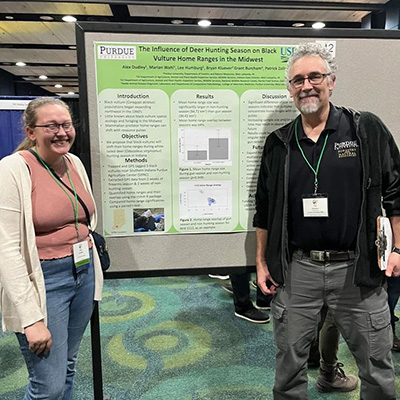 Dudley said that the conference allowed her to step out of her comfort zone, while also giving her a chance to present her own research.
Dudley said that the conference allowed her to step out of her comfort zone, while also giving her a chance to present her own research.
“Overall, this conference allowed me to make connections with students and professionals across the country, learn about new research, and gain a better idea of what I might like to do after graduating,” Dudley said. “The main thing I learned was how to network. In general, I’m an introvert, so going up to random strangers and starting a conversation is really unnerving. However, the other Purdue students & faculty I attended the conference with really encouraged me to get out of my comfort zone and talk to people. Even though I’m not the best at striking up a conversation, everyone at the conference was super nice and willing to share their story or give advice. I was able to meet a lot of students and professionals through Quiz Bowl and the various networking events. The Student Chapter Leaders Lunch allowed student chapter officers from all across the country to get together and share ideas on improving administrative duties, engaging students, and getting involved with professionals. The student-professional networking event gave me the chance to meet a bunch of professionals in a wide variety of fields including academia, the federal government, state governments, and non-profits. During the poster networking event, I got to meet a graduate student whose research is really similar to mine but focusing on peccaries. Overall, I was able to learn a lot and get a lot of helpful advice from the other wildlifers I met at the conference.
“I also had the experience of presenting my first research poster (The Influence of Deer Hunting Season on Black Vulture Home Ranges in the Midwest), which was scary but exciting at the same time. I’ve been working with Dr. Zollner and his PhD student Marian Wahl since my freshman year, so finally getting to present and get feedback on the research I’ve been doing for most of my Purdue career was really cool.”
Master’s student Shelby Royal gave an oral presentation on “Advancing Captive Rearing for an Endangered Species: Raceway Size Affects Growth on Eastern Hellbenders,” and was able to gather ideas from other researchers she met.
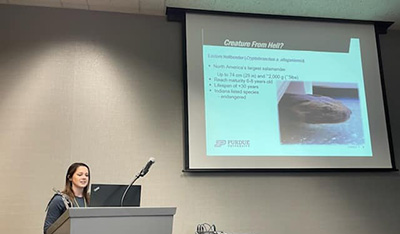 “Large conferences like TWS are a really exciting experience,” said Royal, a 2019 wildlife alumna. “You get to meet so many new people and get to see some of the work they are doing. That, in itself, can help figure out what route you want to go or how you can implement different methods into your own work. I got to meet and chat with a lot of other students and professionals that work with amphibians. It really helps when there are difficult situations to have people from other backgrounds to bounce ideas off of. My favorite experience was being able to see the West Coast. I had never been able to travel that way, so it was cool to see such a diverse place and how beautiful Washington is, even if it snowed most of the time.”
“Large conferences like TWS are a really exciting experience,” said Royal, a 2019 wildlife alumna. “You get to meet so many new people and get to see some of the work they are doing. That, in itself, can help figure out what route you want to go or how you can implement different methods into your own work. I got to meet and chat with a lot of other students and professionals that work with amphibians. It really helps when there are difficult situations to have people from other backgrounds to bounce ideas off of. My favorite experience was being able to see the West Coast. I had never been able to travel that way, so it was cool to see such a diverse place and how beautiful Washington is, even if it snowed most of the time.”
PhD student Jonathan Brooks, who gave an oral presentation on “Effectiveness of an Artificial Ecological Trap for Mitigating Chronic Wasting Disease Spread in White-tailed Deer,” was able to connect with other researchers working with chronic wasting disease.
“My greatest takeaway was that there are more people working on the issue of chronic wasting disease than I imagined, however they are all approaching the issue from different angles,” Brooks said. “It was amazing how those experiences sparked ideas and possible new directions for my own research. I was most interested to learn about the work being done to use buck rubs as a way of conducting chronic wasting disease surveillance. I was able to reconnect with a number of students and researchers I had met at previous conferences and was able to build new contacts with students from universities such as Michigan State, North Carolina State, and University of Georgia. It was great to see the progress they have made and the new ideas they had come up with.”
Murray said the conference not only allowed her to learn and network with others from across the country, but connect more deeply with her Purdue colleagues.
“Attending a professional conference as a student is intimidating yet very exciting,” Murray said. ”I loved being able to learn about the different research being done globally in the wildlife field by attending talks and poster sessions, networking with professionals and students (graduate and undergraduate) and representing Purdue in the Quiz Bowl competition. While I learned so much from all the different presentations I watched and people I talked to, I think my main takeaway from the conference was building the confidence to engage with professionals and the research presented through conversation and asking 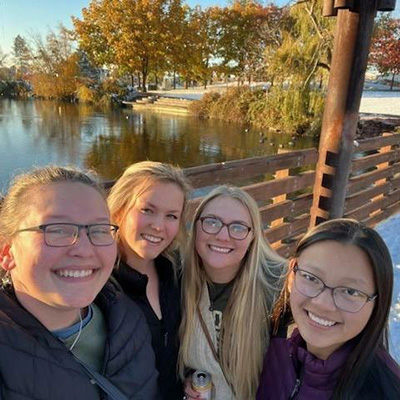 meaningful questions. I made great connections with students and professionals from all over the country, but I think the most lasting connections I created were with the Purdue students and faculty I was able to attend with. Through reflecting on our days, getting dinner together, and having great conversations, I feel like I was able to connect with my peers and professors on a deeper level and create great memories together!
meaningful questions. I made great connections with students and professionals from all over the country, but I think the most lasting connections I created were with the Purdue students and faculty I was able to attend with. Through reflecting on our days, getting dinner together, and having great conversations, I feel like I was able to connect with my peers and professors on a deeper level and create great memories together!
“My favorite experience from the conference was actually the very last event on the itinerary - the IDEA Working Group Storytelling Event. During this, different wildlife professionals went up and told personal stories from experiences in their careers or graduate school and messages that came from these stories. I loved this event because each story brought in a more human element to wildlife careers rather than just science and they were both humorous and emotional.”
Talbot also came away from the conference with increased knowledge and research connections.
“I think one of the best connections I made was with another undergraduate student,” Talbot said. “I met her at a social event, and we connected over Northern Saw-Whet Owls. I will be co-leading Purdue's Northern Saw-Whet Owl banding station, so it was nice to talk to a student also leading their university's banding station. Overall, the convention was an amazing experience. I am so grateful that I was able to attend and represent Purdue. It was a great way to meet new people and hear about the research people are doing. As an undergrad, it was hard to imagine that I could ever relate to these professionals but meeting them and talking to them helped me see that they are people just like me."
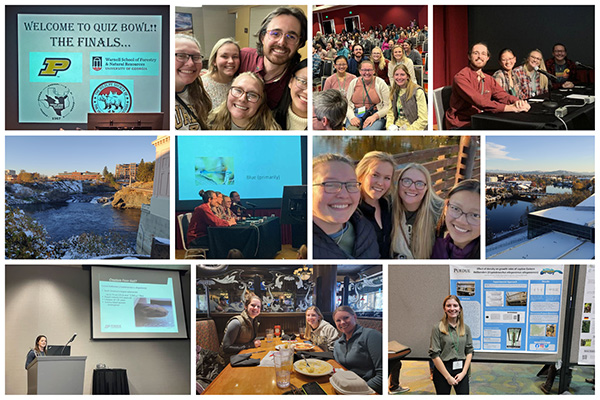 Photos from the 2022 The Wildlife Society conference in Spokane, Washington. Top row (Left to Right): The sign welcoming the Quiz Bowl finalists; the 2022 Purdue Quiz Bowl team huddles for a photo; the Quiz Bowl team with fellow Purdue undergraduate Summer Brown; the Quiz Bowl team competing. Row 2 (Left to Right) - The Quiz Bowl team with a question on the projection screen beside them; members of the Quiz Bowl team take in Spokane; A photo of the snow and mountains outside the hotel. Row 3 (Left to Right): Master's degree student Shelby Royal presenting her research on eastern hellbenders; Royal with Purdue undergrad Summer Brown and University of Kentucky PhD student Sarah Tomke eat dinner together at the TWS conference, all three are researching hellbenders; Summer Brown with her poster on hellbender research.
Photos from the 2022 The Wildlife Society conference in Spokane, Washington. Top row (Left to Right): The sign welcoming the Quiz Bowl finalists; the 2022 Purdue Quiz Bowl team huddles for a photo; the Quiz Bowl team with fellow Purdue undergraduate Summer Brown; the Quiz Bowl team competing. Row 2 (Left to Right) - The Quiz Bowl team with a question on the projection screen beside them; members of the Quiz Bowl team take in Spokane; A photo of the snow and mountains outside the hotel. Row 3 (Left to Right): Master's degree student Shelby Royal presenting her research on eastern hellbenders; Royal with Purdue undergrad Summer Brown and University of Kentucky PhD student Sarah Tomke eat dinner together at the TWS conference, all three are researching hellbenders; Summer Brown with her poster on hellbender research. Posters and Presentations by FNR Personnel at TWS 2022
The Influence of Deer Hunting Season on Black Vulture Home Ranges in the Midwest – poster presented by Alex Dudley. Co-authored by Marian Wahl, Lee Humberg, Bryan Kluever, Grant Burcham and Dr. Patrick Zollner.
Effectiveness of an Artificial Ecological Trap for Mitigating Chronic Wasting Disease Spread in White-tailed Deer – oral presentation by Jonathan Brooks, Dr. Pat Zollner
Advancing Captive Rearing for an Endangered Species: Raceway Size Affects Growth on Eastern Hellbenders – oral presentation by Shelby Royal
Land Use Gradients Shaping Mammalian Community in the Fragmented Landscape of Bellary District, India – oral presentation by Asit Behera, Dr. Pat Zollner
Effect of Density on Growth Rates of Captive Eastern Hellbenders – poster presentation by Summer Brown. Co-authored by Shelby Royal, Nick Burgmeier
Raceway Size Affects Growth and Food Intake in Captive-Reared Juvenile Eastern Hellbenders – oral presentation by Purdue Extension wildlife specialist Nick Burgmeier, co-authored by Shelby Royal
Using Cost-Effectiveness Analysis to Compare Density-Estimation Methods for Large-Scale Wildlife Management – oral presentation by Zack Delisle
Determining White-Tailed Deer Preferences and Changes in Preferences of Woody Species in the Central Hardwood Forest Region – oral presentation by Zack Delisle, co-authored by Richard Sample, Dr. Mike Jenkins
Examining Scavenger Behavior in a South African Agricultural Setting – poster presented by Gabrielle Dennis. Co-authored by Dr. Pat Zollner
Role of Anthropogenic Foods on Black Bears Demographics in Maine Revealed Through Stable Isotope Analysis – oral presentation co-authored by Dr. Elizabeth Flaherty
Examining Vulture Aggression and Scavenging Behavior Using Remote Cameras – poster presented by Amanda Herbert. Co-authored by Brandon Quinby, Marian Wahl and Dr. Pat Zollner.
Characterizing the Pattern and Sequence of Vulture Scavenging of Neonatal Cattle Carcasses – oral presentation by Amanda Herbert, Marian Wahl, PhD alumnus Brandon Quinby and Dr. Pat Zollner
The Influence of Deer Hunting Season on Black Vulture Home Ranges in the Midwest – poster presented by Marian Wahl. Co-authored by Dr. Pat Zollner.
